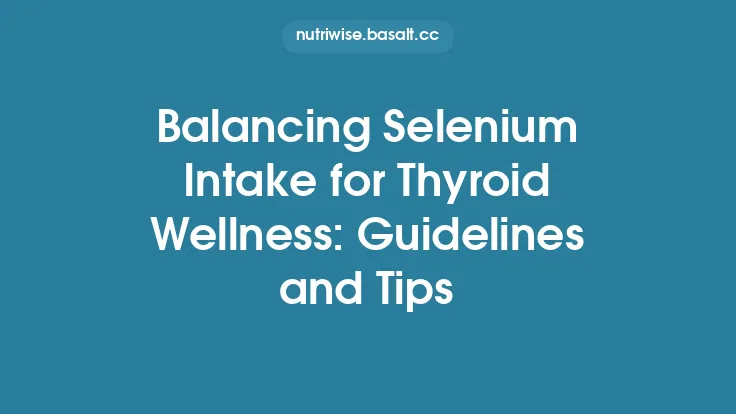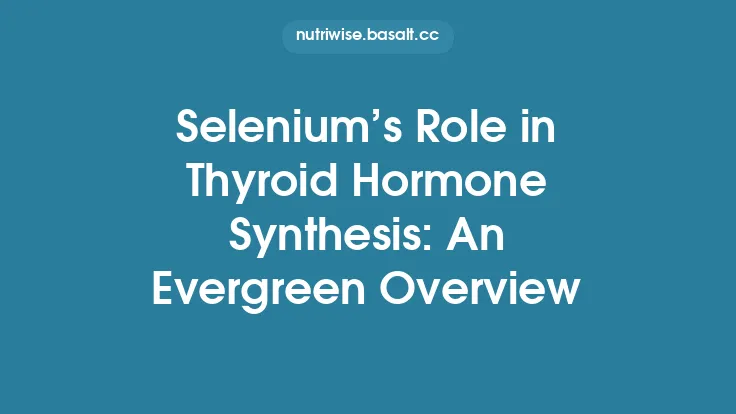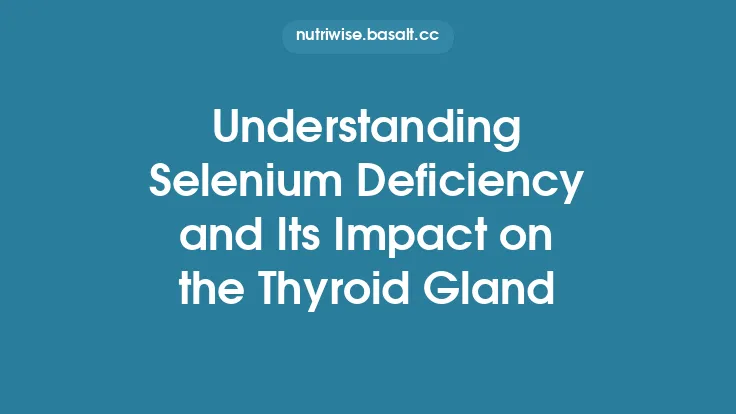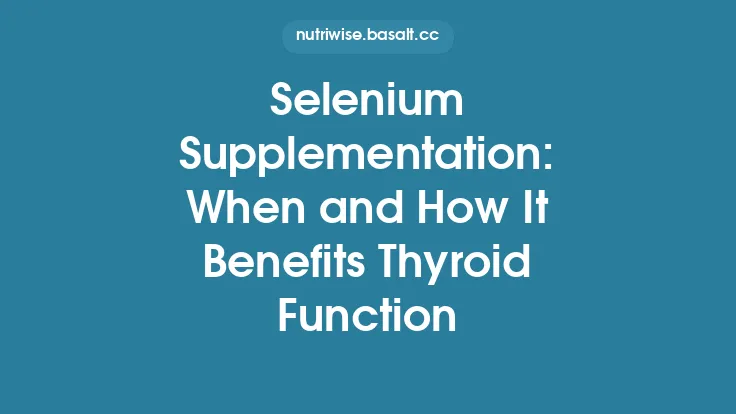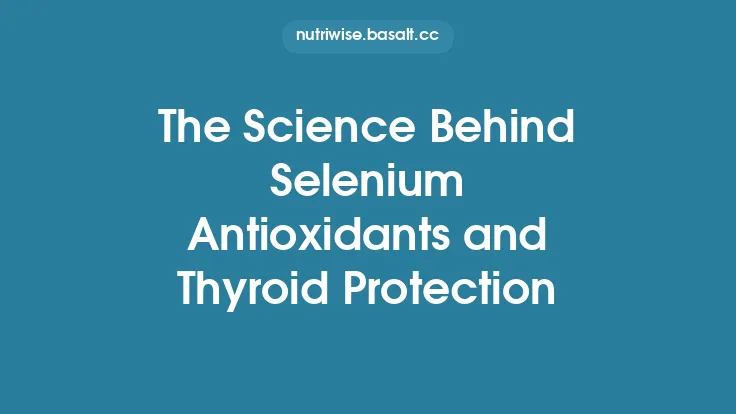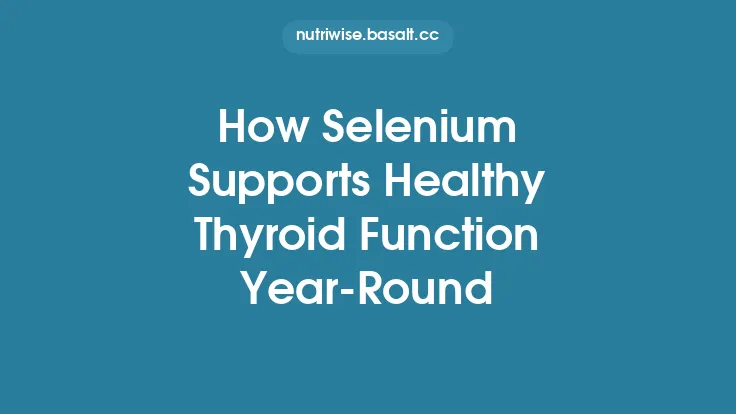Iodine and selenium are two of the most critical trace elements for the proper functioning of the thyroid gland. While each mineral has its own distinct biological roles, their collaboration is essential for the synthesis, activation, and protection of thyroid hormones. Understanding how these micronutrients interact provides a solid foundation for maintaining thyroid health, preventing disease, and optimizing overall metabolic balance.
The Biochemistry of Thyroid Hormone Production
Iodine’s Central Role
Iodine is a key component of the thyroid hormones thyroxine (T₄) and triiodothyronine (T₃). The thyroid follicular cells actively concentrate iodide from the bloodstream via the sodium‑iodide symporter (NIS). Inside the follicular lumen, iodide is oxidized by thyroid peroxidase (TPO) and incorporated into the tyrosine residues of thyroglobulin, forming monoiodotyrosine (MIT) and diiodotyrosine (DIT). Coupling of these iodinated residues yields T₄ (two DITs) and T₃ (one MIT + one DIT). The hormone‑laden thyroglobulin is then endocytosed, proteolytically cleaved, and the free hormones are released into circulation.
Selenium‑Dependent Deiodinases
Although the thyroid gland secretes a large amount of T₄, the biologically active hormone at the cellular level is T₃. Conversion of T₄ to T₃ is mediated by a family of selenoproteins known as iodothyronine deiodinases (DIO1, DIO2, and DIO3). These enzymes contain the amino acid selenocysteine at their active site, which is essential for catalyzing the removal of an iodine atom from the outer (DIO1, DIO2) or inner (DIO3) ring of the hormone molecule.
- DIO1 is primarily expressed in the liver, kidney, and thyroid, contributing to systemic T₃ production.
- DIO2 is abundant in the brain, pituitary, and brown adipose tissue, providing local T₃ for tissue‑specific regulation.
- DIO3 inactivates thyroid hormones by converting T₄ to reverse T₃ (rT₃) and T₃ to T₂, thus protecting tissues from excess stimulation.
Without adequate selenium, the activity of these deiodinases declines, leading to impaired conversion of T₄ to T₃, accumulation of rT₃, and a functional hypothyroid state despite normal circulating T₄ levels.
Mutual Dependence: Why Iodine and Selenium Must Be Balanced
Preventing Oxidative Damage
Thyroid hormone synthesis is an oxidative process. The generation of hydrogen peroxide (H₂O₂) by the enzyme dual oxidase (DUOX) is required for TPO‑mediated iodination. However, excess H₂O₂ can damage cellular membranes, proteins, and DNA. Selenium‑containing glutathione peroxidases (GPx) and thioredoxin reductases (TrxR) neutralize H₂O₂, safeguarding follicular cells from oxidative injury. Inadequate selenium therefore amplifies the risk of iodine‑induced oxidative stress, potentially leading to thyroiditis or nodular disease.
Modulating Autoimmunity
Autoimmune thyroid disorders, such as Hashimoto’s thyroiditis and Graves’ disease, are characterized by the presence of antibodies against thyroid peroxidase (TPO‑Ab) and thyroglobulin (Tg‑Ab). Selenium’s incorporation into selenoproteins exerts anti‑inflammatory effects by dampening the production of pro‑inflammatory cytokines (e.g., IL‑6, TNF‑α) and reducing oxidative stress, both of which are triggers for autoantibody formation. Clinical trials have demonstrated that selenium supplementation can lower TPO‑Ab titers, especially when iodine intake is within the recommended range, underscoring the synergistic protective effect.
Hormonal Feedback Loops
The hypothalamic‑pituitary‑thyroid (HPT) axis relies on precise feedback mechanisms. Elevated T₃ suppresses thyrotropin‑releasing hormone (TRH) and thyroid‑stimulating hormone (TSH) secretion, while low T₃ stimulates them. Selenium deficiency impairs T₃ production, leading to a compensatory rise in TSH, which in turn drives the thyroid to increase iodine uptake. This heightened iodine influx, in the context of insufficient antioxidant capacity, can exacerbate oxidative damage. Thus, a balanced supply of both iodine and selenium stabilizes the feedback loop and prevents maladaptive glandular hyperactivity.
Dietary Sources and Bioavailability
| Nutrient | Rich Food Sources | Typical Bioavailability* |
|---|---|---|
| Iodine | Seaweed (kelp, nori), iodized salt, dairy (milk, yogurt), eggs, fish (cod, haddock) | 70–90 % (higher from marine sources) |
| Selenium | Brazil nuts (1–2 nuts meet >100 % RDA), seafood (tuna, sardines, shrimp), organ meats (liver, kidney), cereals (depending on soil) | 50–80 % (organic selenomethionine > selenite) |
\*Bioavailability varies with food matrix, cooking method, and individual gut health.
Interactions with Other Dietary Factors
- Goitrogens (e.g., glucosinolates in cruciferous vegetables) can inhibit iodine uptake but are generally not problematic when iodine intake meets or exceeds the Recommended Dietary Allowance (RDA) of 150 µg/day for adults.
- High‑dose iron or calcium supplements may transiently reduce iodine absorption if taken simultaneously; spacing them by at least two hours mitigates this effect.
- Vitamin A enhances the expression of the sodium‑iodide symporter, indirectly supporting iodine utilization, but this interaction lies outside the primary focus on iodine‑selenium synergy.
Clinical Implications of Imbalance
Iodine Deficiency with Adequate Selenium
In regions where iodine intake is low, the thyroid compensates by increasing NIS activity, but the limited substrate leads to reduced hormone synthesis. Adequate selenium can still protect the gland from oxidative stress, yet the primary problem—insufficient hormone production—remains. Clinical manifestations include goiter, cretinism in severe cases, and mild hypothyroidism.
Selenium Deficiency with Adequate Iodine
When iodine intake is sufficient but selenium is lacking, deiodinase activity drops, resulting in:
- Low serum T₃ despite normal or elevated T₄.
- Elevated reverse T₃ (rT₃) levels.
- Symptoms of “low‑T₃ syndrome” such as fatigue, weight gain, and cold intolerance.
- Increased susceptibility to autoimmune thyroiditis due to unchecked oxidative stress.
Excess Iodine in Selenium‑Deficient Individuals
High iodine loads (e.g., from over‑use of iodized salt or seaweed supplements) can precipitate the Wolff–Chaikoff effect—a temporary inhibition of hormone synthesis. In selenium‑deficient persons, the gland’s ability to escape this block is compromised, potentially leading to persistent hypothyroidism.
Assessment and Monitoring
Laboratory Evaluation
- Serum Thyroid Panel: TSH, free T₄, free T₃, and reverse T₃ (if available) provide a functional snapshot.
- Selenium Status: Plasma selenium concentration, selenoprotein P levels, or glutathione peroxidase activity are reliable markers.
- Iodine Status: Urinary iodine concentration (UIC) reflects recent intake; a median UIC of 100–199 µg/L indicates adequate intake for the general population.
- Autoantibodies: TPO‑Ab and Tg‑Ab titers help gauge autoimmune activity, especially when selenium supplementation is considered.
Interpreting Results in Context
- A high TSH with low free T₃ but normal free T₄ suggests impaired peripheral conversion—pointing toward selenium deficiency.
- Elevated TPO‑Ab with normal thyroid function may still benefit from selenium supplementation to curb antibody progression.
- Low UIC combined with normal selenium levels warrants iodine repletion, preferably through diet rather than high‑dose supplements to avoid overshoot.
Practical Recommendations for Optimizing the Iodine‑Selenium Axis
- Aim for Balanced Intake: Target 150 µg/day of iodine and 55 µg/day of selenium for most adults (higher needs in pregnancy, lactation, and certain disease states).
- Incorporate Whole‑Food Sources: A weekly serving of seaweed (≈200 µg iodine) plus a handful of Brazil nuts (≈200 µg selenium) can meet both requirements without resorting to synthetic supplements.
- Consider Targeted Supplementation:
- Mild Selenium Deficiency: 100–200 µg of selenomethionine per day for 3–6 months, reassessing status thereafter.
- Iodine Repletion: Use iodized salt (≈45 µg iodine per gram) or a modest kelp capsule (≈150 µg iodine) under professional guidance.
- Monitor Periodically: Re‑check thyroid panel and selenium status after 3–6 months of intervention to ensure the desired hormonal balance and avoid excess.
- Avoid Over‑Supplementation: Chronic intake >1 mg/day of iodine or >400 µg/day of selenium can provoke toxicity, including thyroid dysfunction and selenosis (hair loss, nail brittleness, gastrointestinal upset).
Special Populations
Pregnancy and Lactation
- Iodine: Requirement rises to 220–250 µg/day to support fetal neurodevelopment and maternal hormone production.
- Selenium: Needs increase to ~70 µg/day; adequate selenium protects against pregnancy‑related thyroid autoimmunity and supports antioxidant defenses in the placenta.
Elderly
Age‑related decline in gastric acidity can impair iodine absorption, while selenium status often falls due to reduced dietary variety. Monitoring and modest supplementation can help maintain euthyroid status and prevent cognitive decline linked to low T₃.
Athletes and High‑Stress Individuals
Intense physical stress elevates cortisol, which can suppress deiodinase activity. Ensuring sufficient selenium supports efficient T₄‑to‑T₃ conversion, aiding metabolic rate and recovery.
Emerging Research Directions
- Genetic Polymorphisms: Variants in the *DIO2 and SEPP1* genes influence individual responsiveness to selenium and iodine intake, opening avenues for personalized nutrition.
- Nanoparticle Delivery: Selenium nanoparticles are being explored for targeted thyroid delivery, potentially enhancing deiodinase activity with lower systemic doses.
- Microbiome Influence: Gut bacteria capable of deiodinating thyroid hormones may modulate systemic T₃ levels; selenium’s role in shaping the microbiome is an active area of investigation.
Bottom Line
The collaboration between iodine and selenium is a cornerstone of thyroid hormone homeostasis. Iodine supplies the raw material for hormone synthesis, while selenium equips the gland with the enzymatic tools to convert, activate, and protect those hormones. A balanced intake—achieved primarily through a varied diet rich in marine foods, dairy, nuts, and whole grains—supports optimal thyroid function, reduces the risk of autoimmunity, and safeguards against oxidative damage. Regular assessment of both micronutrients, especially in vulnerable groups such as pregnant women, the elderly, and individuals with thyroid disorders, ensures that the delicate iodine‑selenium partnership remains in harmony, promoting overall metabolic health.
